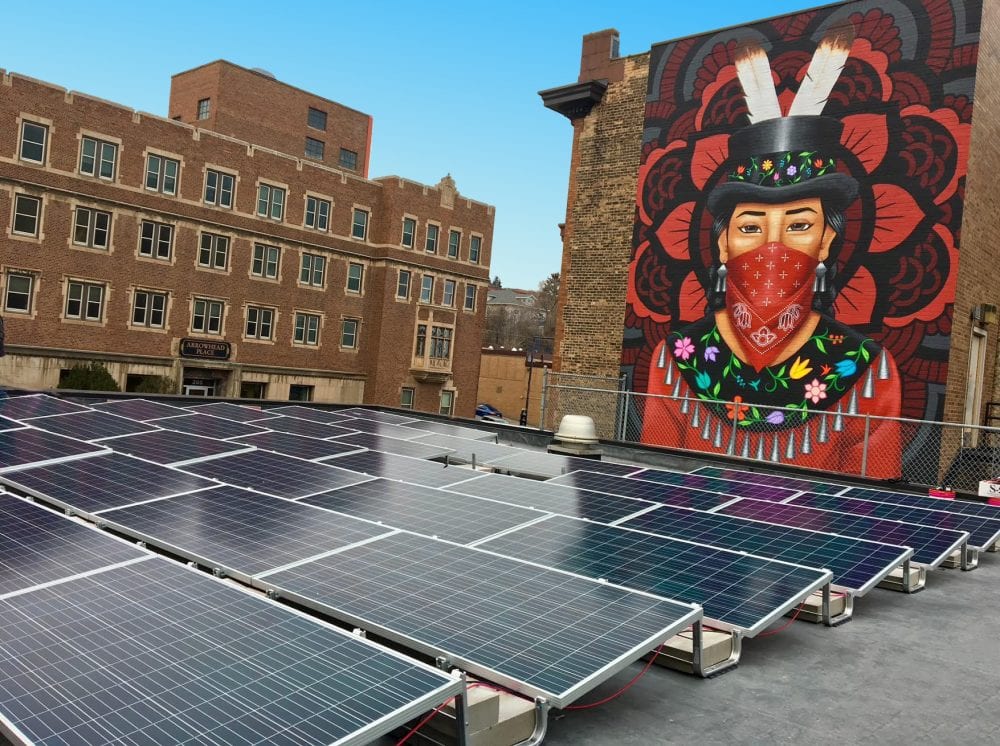
A mural of an Ojibwe Water Protector looks over rows of solar panels in Duluth, Minnesota. The mural was a collaboration between Honor the Earth, the American Indian Community Housing Organization, and an indigenous artist collective, NSRGNTS. Photo courtesy of AICHO
“Ojibwe people and other American Indians have a cultural philosophy known as the Seventh Generation Principle,” Ivy Vainio said. “Everything we do now will have an impact on those who live seven generations after us. Tribal leaders, elders, and community members know the importance of living a sustainable and culturally minded life for the generations that follow.”
In 2017, the American Indian Community Housing Organization (AICHO) based in Duluth, Minnesota, was one of five urban organizations in the United States to receive a Climate and Cultural Resiliency grant of $100,000 from Enterprise Community Partners to incorporate arts, culture, and creativity into climate resilience projects. Shelterforce discusses the connections between cultural and climate resiliency as well as Indigenous agency with AICHO’s Art, Climate, and Cultural Program Coordinator Ivy Vainio and Economic Development Director LeAnn Littlewolf.
Brandon Duong: American Indians make up 3.5 percent of Duluth’s population yet the American Indian community does not have an influence over the policy decisions that affect them. Could you talk a bit more about how this grant ties into these ideas of autonomy and agency for the American Indian community in Duluth?
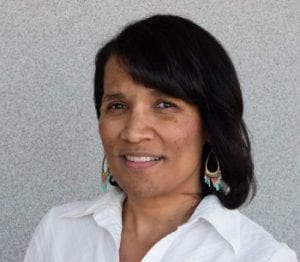
Ivy Vainio is the art, climate, and cultural program coordinator for the American Indian Community Housing Organization.
Ivy Vainio: The grants that we received, we were able to partner with several tribal and Duluth urban organizations to make cultural and environmental practices happen.
We partnered with an organization to help us put a solar array on our rooftop. We also collaborated with Indigenous artists and Indigenous folks that work in tribal natural resources departments and on the reservation to bring about awareness to the community on Indigenous ways of thinking and protecting resources, water, land, our air.
It allowed for greater connection to AICHO [American Indian Community Housing Organization], and it built up AICHO in a lot of circles that normally wouldn’t have happened within the city and with the tribe. Even after the grant was finished, we’re still being asked to participate in environmental sustainability projects in the city with the tribe. I just got asked to be on an advisory board with the Fond du Lac band of Ojibwe Natural Resources Department on a project of theirs because of my work with this grant in 2017.
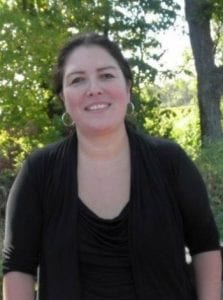
LeAnn Littlewolf (Anishinaabe/Gaa-zagaskwaajimekaag Band of Ojibwe) is currently the economic development director at the American Indian Community Housing Organization.
LeAnn Littlewolf: AICHO is a nonprofit organization. We’ve been in place since 1993, and we started out very small. We’ve steadily grown and built capacity. We started doing emergency shelter for people who are experiencing violence, and then housing, and then just adding programming and services.
We’re very focused on direct services. With that came political advocacy as we work for rights for people who were experiencing violence, and all of the other root causes of what makes people vulnerable. As a tribal people, sovereignty is so critical to who we are for our political identity and just for our cultural collective consciousness. It’s like the core theme all the time, self-determination.
For us to be able to [have] this enterprise reflected nationally, we [can] showcase our work. We were able to meld a true cultural perspective with cultural elements into each of the events with the way that the events were opened, with our traditional prayer, traditional ceremony, [and] who the speakers were.
[To] have our native community members seen as leaders and experts, a lot of times that’s hidden. We have people that have a lifetime of knowledge, and that’s not acknowledged.
So, when we acknowledge it, that gives our community agency. Ivy also organized an advisory committee made of native elders, chief stakeholders, and knowledge holders to guide the process. That’s an old practice to have our elders and those with knowledge to guide.
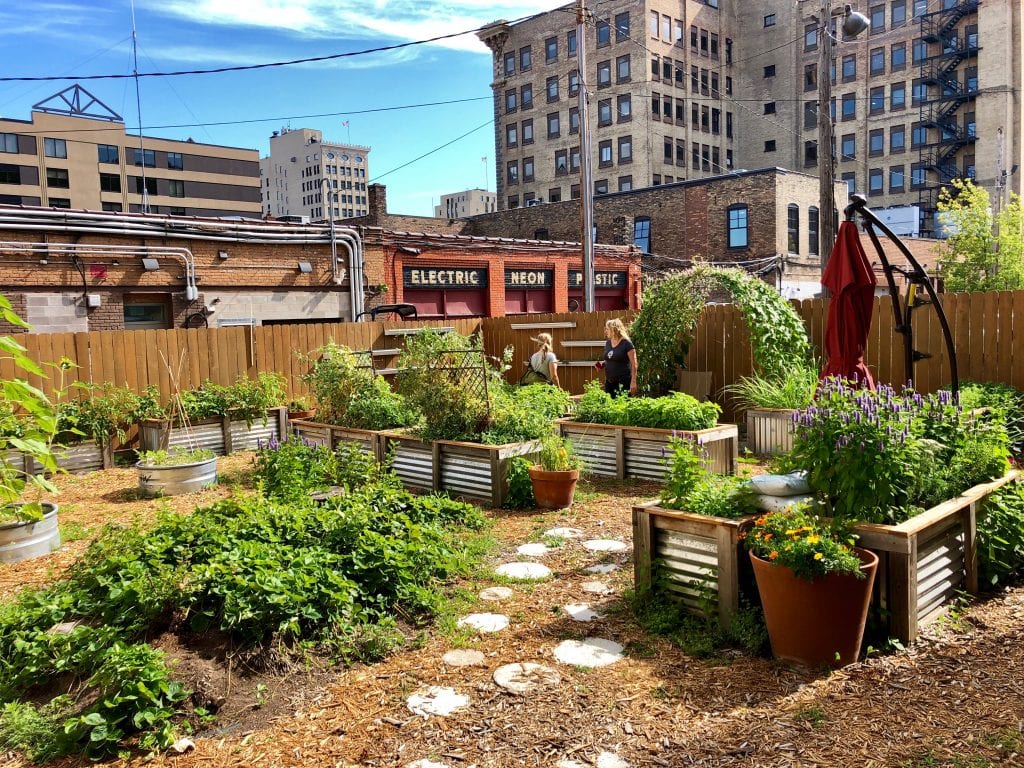
Residents at AICHO’s Gimaajii housing development lead and tend to crops at Gimaajii Gardens. Photo courtesy of AICHO
How would you define cultural and climate resilience? And how do you see those two connecting to one another?
Littlewolf: You build cultural resiliency by keeping the cultural practices alive by doing it, and the community having access to that. As native people, a lot of our traditional practices were stripped from us by the U.S. We weren’t allowed to do them. We were disconnected from them directly by federal policy.
In Duluth, [American Indians are] 3.5 percent of the population. A small percent, but Duluth is our homeland. Duluth is on ceded territory. This was Anishinaabe land. That’s something that is never acknowledged. AICHO taking the lead on climate resiliency first is from asserting [that] we have a tie to this land. It goes back a long time, before visitors arrived to this land.
We have a responsibility to be in relationship with this land and this world. That’s how you gain: You be who you are and you revitalize those practices and make it accessible.
For community members who are considered the most vulnerable, [who] haven’t had access to resources, who’ve been mistreated in our systems, those families who live in our current supportive housing have access to events and help organize these events. They’re the ones that grow [and] take care of the food.
That’s how we build agency, because this is all community-owned. From that, we added Gimaajii [which is a supportive housing program of AICHO], and we were doing well with climate resiliency, and then we launched food sovereignty work.
And we did it with our economic development work. We bought a corner grocery store that [is] in development right now, and that’s going to be the region’s first Indigenous food market. I don’t think there’s very many nationwide, but it will focus on Indigenous food with access to healthy, fresh food for the local low-resource neighborhood.
It’s interesting to hear the way you’re defining cultural resilience. I know that your organization started a Climate and Cultural Resilience Advisory Council. Do you have any updates on what the council’s been working on since then?
Vainio: Once the grant ended, so did the official sense of the advisory council. We haven’t met since. But we still are connected to folks that were on the advisory council, and we still rely on them. We still hire them to bring forth more awareness and their connection to the land and resources and things like that. We’re still calling upon these folks to help us maintain and increase our knowledge, as well as the community, through presentations and things like that.
How do you see the Indigenous view about the environment and the relationship with humans? Do you think that’s different from the mainstream view of environmentalism?
Littlewolf: Yes. There’s a local group that works on clean energy and climate preparedness for our city. They were going to interview stakeholders, and they started out with some beginning goals. It was written in a strategic plan kind of format, and the language was very focused on the concrete results and the technical policy.
One of the things that we add in when we added Indigenous perspective is the core reason about why we do this and about concern for our community, concern for the environment. There’s a different perspective on land. It’s not a resource, but it’s an entity that we have a relationship with that’s built over time.
When I’m in different groups that are working on building local food systems or helping a community become more resilient in the face of climate change, a lot of times that [relationship with the land] is missing.
One example: There’s a Living Labs group that has a cohort here in Duluth, in Thunder Bay, and in Sault Ste. Marie. They got a grant through the universities. They built it recognizing that we’re on Indigenous land and [with] respect for Indigenous people. But then, when I got to the meeting, there were no other Indigenous people there.
It was a lot of biologists and environmental faculty/staff, local food systems stakeholders. We started saying, “OK, so this is centered around Lake Superior, and for us this is a region that transcends these artificial boundaries of states and United States and Canada. Our Anishinaabe country extends from north of the St. Lawrence River all the way out to Montana to Rocky Boy.”
It resonated with everybody at that meeting, but it’s a totally different perspective than “Here’s our strategy, bullets one through five and here are our action steps.” It doesn’t feel like there’s connection to community, which is always our first and foremost priority.
The environmental groups have great strategies and great vision. They’ve got great drive. But a lot of times they forget about our community and about the people who are actually going to be most impacted. If there’s a climate crisis event, who is going to suffer the most? Who is going to be at most risk? And how are you connecting and engaging with the people?
That’s why AICHO’s leadership through this grant was so important, because it really showed people that AICHO is an environmental group [as well] as an arts and cultural hub.
Our partners who work on environmental issues and moving policy at the local, state, federal level, are so enthralled to come to AICHO. They have directly said to me they’re so grateful for AICHO and the approach that AICHO offers around doing education and engaging the community around what issues are facing us, and [how] we want to tie back to people’s real experiences.
A couple years ago, we had a severe storm that knocked out the power for two weeks for some neighborhoods. People lost whatever was in their fridge. [In a] lot of the neighborhoods, if my fridge got knocked out and I lost all my food, I can’t just go replace that. A lot of households can’t do that.
We started asking other questions, like who needs medications to be kept at a certain temperature, and how are they going to do that? For AICHO, we started to look at our space, and we really tried to get funds and support to get a battery for our solar array.
We looked at this model on the East Coast when they built affordable housing, but they also put a community center in place—a resiliency center. They figured out how many days of electricity that they would need and what they would need that for, and to keep the coolers, and then to refrigerate for medications.
This has helped us to start thinking in that direction. In our city, we would be the first ones to build a resiliency center.
We’re in these conversations with people who are really on fire about how do we get ready, how are we ready, what do we need to be ready for. We want our community to survive. We want our community to be well. We want our community to be safe and healthy.
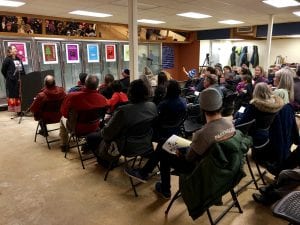
A presentation being given at Niiwin Market. Photo courtesy of AICHO
Did the grant contribute to the resiliency centers? Or is that separate?
Littlewolf: It was a different funding opportunity. And it wasn’t just for funding, but it was a planning grant to participate and learn with a national cohort. We got through the first part to get a full interview, but we didn’t get awarded. So we’re still trying to figure out how we can get a battery for our Gimaajii.
Also, we’re developing two other properties. One’s our Niiwin Market. We want to make sure that we have a solar array on that market, and we would love to have a battery, because the grocery stores that had backup energy sources didn’t lose their products. [The market] became a community hub where people went to gather. So, it’s about maintaining the food and access to food, but it’s also about the community having that product.
That’s what we really envision for our Niiwin Market. Also, we’re developing our artist hub in Lincoln Park, and that will have artist studio space. It will have an art production company, and a coffee shop where there’ll be retail space for art. We also want our solar array there, and for people to have that access to community space.
If you can get the battery in, you can have it if the utility shuts off. You’re in a better spot. We need to have that everywhere. It can’t just be one or two spots in a city.
What are some of the other initiatives that you’ve implemented with the grant? Was the food sovereignty initiative part of the grant?
Vainio: Expanding the rooftop gardens and converting a back lot into a garden. Those are still going and [are] community-led with our Gimaajii housing residents. They have a say in when they plant the seeds, what kind of seeds to plant, and what’s cooked in the kitchen.
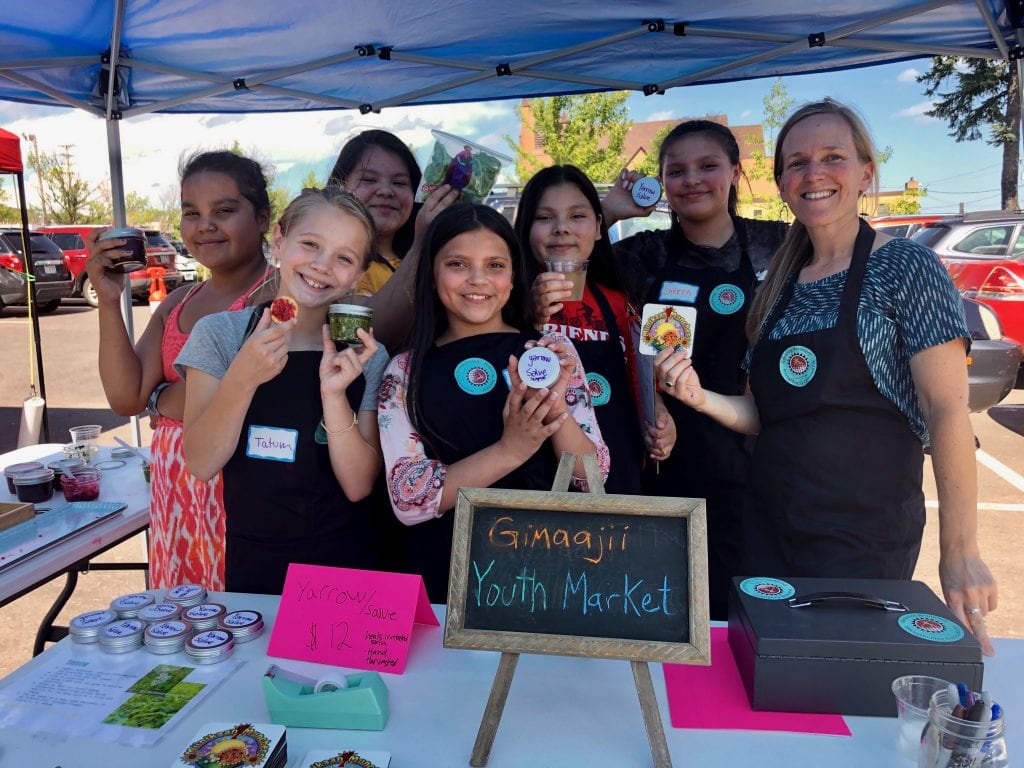
Children smile and pose for the camera at Gimajii Youth Market, which is run by AICHO. Photo courtesy of AICHO
Could you talk about some of the initiatives that you implemented with the grant that are still happening?
Vainio: Yes. The gardens. A lot of it has Indigenous food, so a lot of Indigenous knowledge, [both] new and [what has] always been with us, [continues].
We also with the grant acquired a worm composting bin, a vermicomposting bin. The produce that we don’t use goes into our compost buckets, and then the buckets go down to the bin to feed the worms. And the worms produce this waste, which becomes a fertilizer that we use in the gardens.
Also, we’ve incorporated the youth that live at Gimaajii housing complex. They’re really active with our gardens and with our initiatives. We’re building leaders. Before COVID hit, they were doing summer food markets with products that they made from the garden or that they foraged. And so, they become entrepreneurs, Indigenous food and Indigenous product entrepreneurs.
We [also] do recycling. When the grant came, one of our advisory council members, Jara McLaren, developed a 10-day waste process. And at the end of that 10 days, we all gathered in the lobby of AICHO with residents and community members and staff, and she taught us—we actually got in there in all that waste and separated it and figured out how much waste we did and how much recycling there was, where our waste goes and how we can do recycling and composting better, and all that kind of stuff.
From that, AICHO put out more recycling and composting bins. That’s still in place today because of that. Those are some of the things that I can think of off the top of my head that are still in place.
Littlewolf: We were able to expand our garden space with the grant, and that also led us to start talking about how much access we had for land for growing food. We’re so proud of those garden boxes. The first garden boxes that were made, a couple of staff volunteered to make them. Then people started donating starter plants very spontaneously, and it really took off.
Duluth, like I said, this was Anishinaabe land, and then through the treaty process, it was ceded to the U.S. government. There [were] small tracts of land that became our reservations where our people then went. But Duluth is actually our original homeland, and this area here is really significant to our people. This was our trading center.
We don’t have any acres of land to grow food. So, that was the thought process behind buying this old corner grocery store that had been closed for two years, and it had been around since 1896.
When it closed, it was devastating to that neighborhood. We were able to purchase it, using our capacity. It’s directly linked through our enterprise grants, because we were able to do that thought process and that thinking around our foods.
[RELATED: Done Right, Eliminating Food Deserts Result in Community Oases]
We have these garden boxes [but] how come we don’t have more land? How much more food could we grow? And then, asking how do we produce food? And we’re also doing economic development work, so at the same time we’re asking these questions on how do we support artists and their entrepreneurship and their business, their business startups, and then how do we help? What does our community actually do who are experts in food?
Do our food producers have access to retail space? We started out with no Indigenous food products, and now we have a whole corner of our store that’s dedicated to that, which we hope to expand when we open our Niiwin Market that will really feature and showcase the value of our Indigenous food.
It went from garden boxes to developing a regional food system that really highlights and showcases Indigenous food history. Ivy organized all of these pop-ups for our Niiwin Market—once-a-month events showcasing different elements of our food, culminating in an Indigenous food expo, which was the first in our city and actually the first in our region.
We had over 2,000 people show up to that one-day event, and we had Indigenous chefs, food producers, vendors, and organizations that really work toward Indigenous health and food. We had lacrosse, a three-on-three basketball tournament, live music, and art. And it was all an extension of that initial work from our enterprise grant that Ivy wrote on.
From that, also with the solar array, because of our partnership to get installations to make it happen, we continue to have partnership with the organizations. We’re ready to launch a job training program for our community members to learn how to do solar panel installation. And so, we’re always thinking about economic and racial justice.
We have a partnership between AICHO, Minnesota Energy, Power & Light, and the Whole Foods Co-op. Solar Bear, which is a Native-owned solar panel installation company will do training for our community members. They have an opportunity to get on-the-job paid training to put up what will become Duluth’s largest solar panel array, 65 kilowatts. They’ll have that training and work experience, and Solar Bear has other projects ready to go so they have the opportunity to continue that employment.
We’re really looking at focusing our economic development into the green economy. Those are extensions of the original grant.
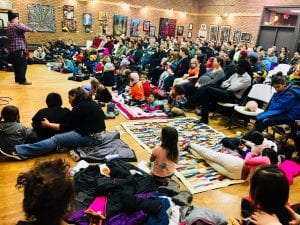
Community members attend a storytelling event hosted by AICHO. Photo courtesy of AICHO
What are some lessons that you’ve learned during this process that you could share with other organizations that are doing similar work? Were there any stumbling blocks, or any things that were useful to keep in mind, just any general advice you would give to other organizations?
Littlewolf: We [recognized] that even within our staff, a lot of the practices [were] unfamiliar. When we talked about composting, that sounds easy but that was implemented over a number of months in helping people get familiar about it and figuring out what it is, what it does, and then get used to doing it.
You have to do those shifts collectively, so we started internally with our staff in our Gimaajii community, then it also translates out into the wider community.
Vainio: Also, making early connections before the project starts with community [is important]. Getting the input of the Indigenous community, creating an advisory council that has the knowledge holders, invite an elder, invite the youth. Youth leadership in all of this is really needed because they are the future.
I’m the communications specialist for AICHO. It’s always important to highlight the folks and the work that’s being done, because it brings awareness and recognition. So, having a big presence with the media, social media, and showcasing our connections, our cultural connections, our urban connection, our partnerships, our projects… only good things come from giving people credit and recognition, and publicly.
You’ve tackled big issues like the pandemic and climate change, and you’ve said that you have educated people about the importance of taking individual responsibility for their actions to be a part of a larger solution to the difficulties that they’re facing. What do you mean by individual responsibility? What does this look like in the context of COVID?
Littlewolf: AICHO [has] a built network of Indigenous artists. Ivy was able to connect us with those artists and asked if we wanted to take some of the state public health information and send it out with cultural messaging.
We helped come up with the messaging, but they also came up with these beautiful art pieces that communicated those messages out. The messaging was really based on our cultural values, so it was around protecting Elders, wearing a mask, and keeping our community safe. And it is about that personal and individual initiative, but it contributes to our cultural health and, we think, collectively.
We put a COVID website together, and we were getting 3,000 to 4,000 views a month, and most people were coming back two times, an average of two times, so they were really looking for that information. And they were coming to AICHO to receive it.
Our community really trusts us, so they were coming to that website. Getting that information out there is critical.
Was there anything else that you would like to add about your experience with any of the programs that came out of this grant, or any other lessons that you think are important to communicate to the audience?
Littlewolf: Our mural was a collaboration between Honor the Earth, AICHO, and our Indigenous artist collective, NSRGNTS.
The mural is of an Ojibwe woman in a jingle dress. She’s a Water Protector. It calls attention to missing and murdered Indigenous women. And that’s how our missions are combined. They’re all tied together.
That mural has gained national and international recognition. We have a lot of visitors that come to AICHO just to see the mural, and then we have a longstanding relationship now with the Artist Collective NSRGNTS.
They bring the message around Indigenous sovereignty, Indigenous issues, and the mental crisis and how we need to lean into our culture for the answers for the future.
Vainio: It was the first large-scale Indigenous public art piece in Duluth. And that was a beautiful experience. NSRGNTS came, Votan, Leah, and Derek. Votan is Mayan, and Leah is Pueblo, and Derek is Navajo. Honor the Earth requested NSRGNTS to come to do this mural.
People started to hear about it. It was on the news and it got region-wide that this was happening. People were curious about it, so they would come check it out while they were finishing the painting, and then [the artists would] come up on the roof, and Votan would be like, “Hey, do you want to help us?” They would pass out paintbrushes. Once it was finished, there were over 40 community members from Duluth, [and] as far away as Minneapolis; Madison, Wisconsin. It was everywhere people were coming. And so, it was really a community collective, collaborative effort.
And there’s this one story that I tell when that mural was going up. I was driving into town, and when you come onto Second Street, you can see the mural. I hit a red light, and I looked over. There was this American Indian Elder, and he was walking up the sidewalk to where my car was. He got to the intersection, and he was going up the hill. He turned and saw that mural. Just seeing him, his reaction, and his whole body turning to face that mural, and the mural was looking at him.
And it was so powerful. I can’t even explain it. It was incredible to just have that connection, that deep connection that we are here, that we’re still here on this Indigenous land.
Thank you.

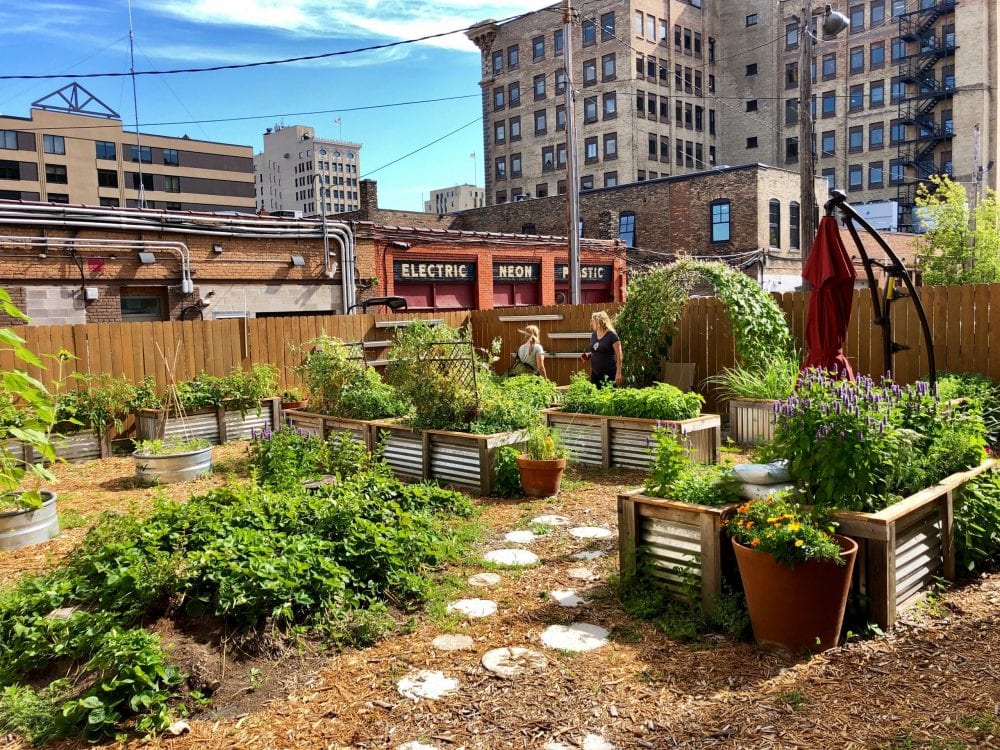



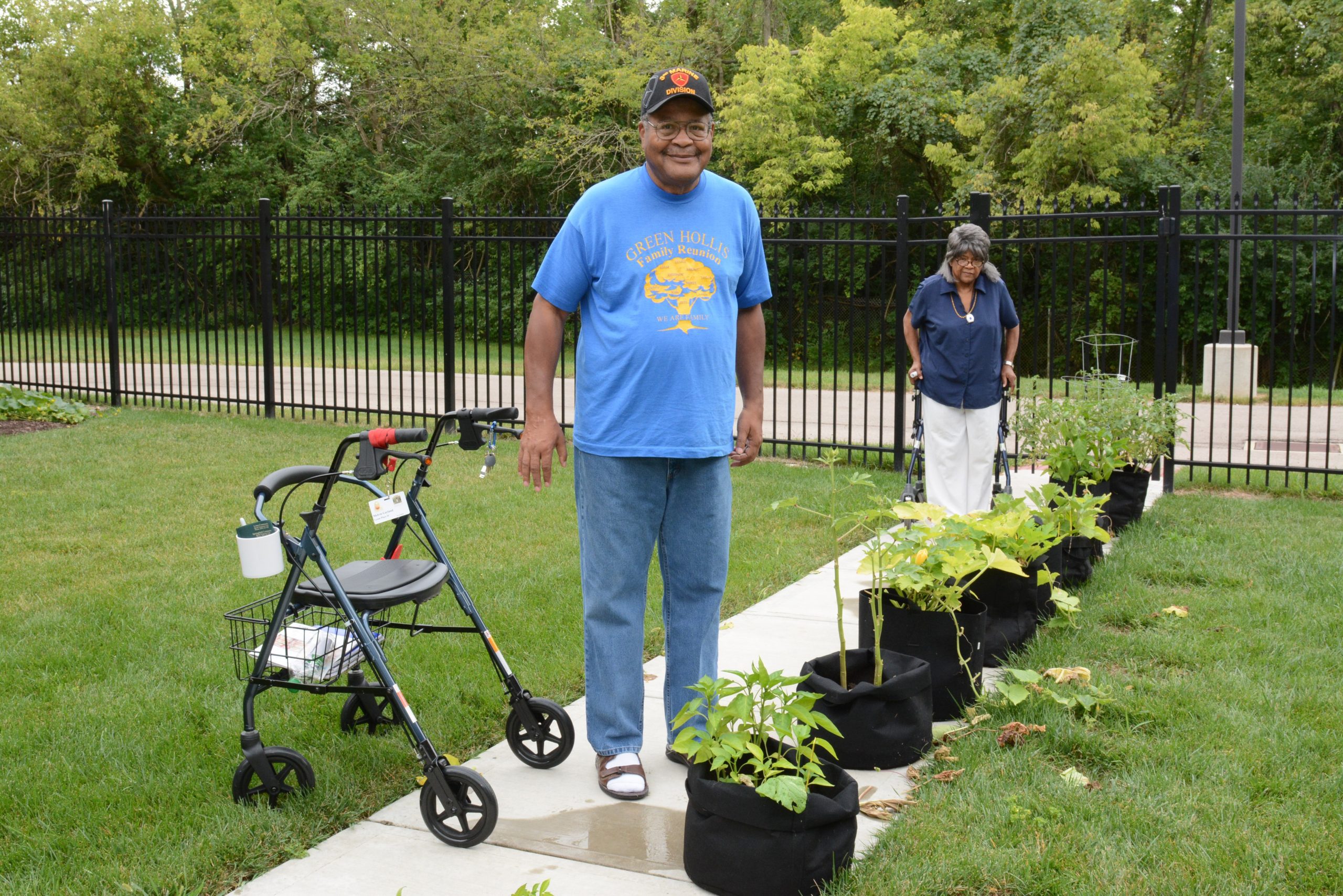
Comments